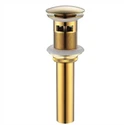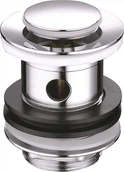What are the challenges in treating Basin Waste?
As a Basin Waste supplier, I've witnessed firsthand the complexities and challenges that come with treating basin waste. Basin waste, which includes water and debris from sinks, basins, and bathtubs, may seem like a simple by - product of daily use. However, its treatment is far from straightforward.
One of the primary challenges in treating basin waste is the diverse nature of its composition. Basin waste can contain a wide range of substances, from organic matter such as food particles, hair, and soap scum to inorganic materials like sand, dirt, and small pieces of plastic. For instance, in a domestic setting, a sink might be used for washing dishes, brushing teeth, and even rinsing out paintbrushes. This means that the waste water can carry everything from grease and food residues to traces of chemicals. In a commercial environment, such as a restaurant or a beauty salon, the complexity increases further. Restaurants generate a large amount of food waste and grease, while beauty salons deal with hair, chemicals from hair dyes and styling products.
The presence of these diverse substances makes it difficult to develop a one - size - fits - all treatment method. Traditional treatment processes may not be sufficient to remove all the contaminants effectively. For example, simple filtration methods may not be able to capture fine particles of grease or dissolved chemicals. This can lead to problems downstream in the treatment system, such as clogging of pipes and reduced efficiency of treatment equipment.
Another significant challenge is the high volume of basin waste generated. In urban areas, with a large population density, the amount of basin waste produced on a daily basis is staggering. This high volume puts a tremendous strain on treatment facilities. Treatment plants need to be able to handle large inflows of waste water continuously. If the treatment capacity is not sufficient, it can lead to overloading of the system, which in turn can result in untreated or partially treated waste being released into the environment.


The issue of space is also closely related to the high volume of waste. Treatment plants require a significant amount of space to accommodate the various treatment processes, such as sedimentation tanks, filtration units, and disinfection chambers. In densely populated cities, finding suitable land for expanding treatment facilities can be extremely difficult and costly.
Cost is yet another major hurdle in treating basin waste. The treatment process involves multiple steps, including collection, transportation, treatment, and disposal. Each of these steps incurs costs. For example, the construction and maintenance of treatment plants require a large initial investment and ongoing operational expenses. The cost of chemicals used in the treatment process, such as disinfectants and coagulants, can also add up quickly. Additionally, the energy required to power the treatment equipment, such as pumps and aerators, is a significant cost factor. These high costs can be a deterrent for local authorities and treatment providers, especially in areas with limited financial resources.
In addition to the physical and financial challenges, there are also regulatory and compliance issues. Governments and environmental agencies have strict regulations regarding the quality of treated waste water that can be discharged into the environment. These regulations are in place to protect public health and the environment. Treatment facilities need to ensure that they meet these standards consistently. This requires regular monitoring and testing of the treated water, which adds to the overall cost and complexity of the treatment process. Non - compliance can result in hefty fines and legal consequences for treatment providers.
Moreover, public awareness and participation play a crucial role in basin waste treatment. Many people are not fully aware of the impact of their actions on the waste treatment system. For example, flushing non - biodegradable items such as wet wipes and sanitary products down the sink or toilet can cause blockages in the pipes and disrupt the treatment process. Encouraging the public to adopt more responsible waste disposal habits is essential for the smooth operation of the treatment system.
As a Basin Waste supplier, we offer a range of products to help address some of these challenges. Our 32mm Basin Waste With Overflow is designed to prevent overflow and ensure a smooth flow of waste water. It has a high - quality filtration system that can capture larger particles, reducing the load on the treatment system. Our bath plug and waste is another innovative product that helps in efficient waste management. It is easy to install and clean, and its anti - clogging design can prevent blockages in the pipes. Additionally, our Sink With Push Down Plug provides a convenient way to control the flow of water and waste, reducing the chances of accidental spills and overflows.
We understand that treating basin waste is a complex and challenging task. However, by working together with treatment providers, local authorities, and the public, we can make significant progress in improving the efficiency and effectiveness of the treatment process. If you are interested in learning more about our products or have any questions regarding basin waste treatment, we encourage you to contact us for a procurement discussion. We are committed to providing high - quality solutions to help you overcome the challenges in basin waste treatment.
References
- "Wastewater Treatment: Principles and Design" by Metcalf & Eddy
- "Environmental Engineering: Fundamentals, Sustainability, Design" by Gilbert M. Masters and Wendell P. Ela
- Various reports from environmental protection agencies on waste water treatment regulations and standards.






